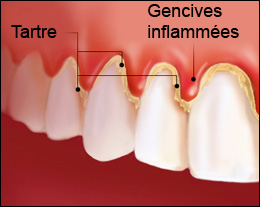
17/02/2015 Dental informations
Gum Disease
1. How common is gum disease?
Very. Seven out of 10 Canadians will develop gum disease at some time in their lives. It is the most common dental problem, and it can progress quite painlessly until you have a real problem. That’s why it is so important to prevent gum disease before it becomes serious.
2. How does gum disease get started?
Gum disease begins when plaque adheres at and below the visible edge of your gums. If plaque is not removed every day by brushing and flossing, it hardens into tartar (also called calculus). Tartar promotes a bacterial infection at the point of attachment. In these early stages, gum disease is called gingivitis.
Your gums may be a bit red, but you may not notice anything. As gingivitis gets more serious, tiny pockets of infection form. Your gums may be puffy and may bleed a little when you brush, but it is not painful. Over time, the infection destroys the gum tissue. Eventually, you may be at risk of losing one or more teeth.
3. How can I prevent gum disease?
Prevention is the most important factor in the fight against gum disease. It is essential to keep your teeth and gums clean. Brush your teeth properly at least twice a day and floss at least once every 24 hours.
Using proper brushing and flossing techniques is equally important. Be sure to see your dentist regularly for professional cleaning and dental exams, so that he or she can detect any early signs of gum disease, and provide appropriate treatment.
4. How can I tell if I’m brushing and flossing properly?
Brushing: Brush your teeth gently, paying special attention to the areas where your teeth and gums meet. Clean every surface of every tooth. Use the tip of your brush to clean behind your upper and lower front teeth.
Flossing: Take a piece of floss about 18 inches long and wrap it around your middle fingers. Using a clean section of floss each time, wrap the floss into a C shape around a tooth. Wipe it over the tooth, from base to tip, a couple of times. Repeat on each tooth.
http://www.cda-adc.ca/en/oral_health/faqs/gum_diseases_faqs.asp







